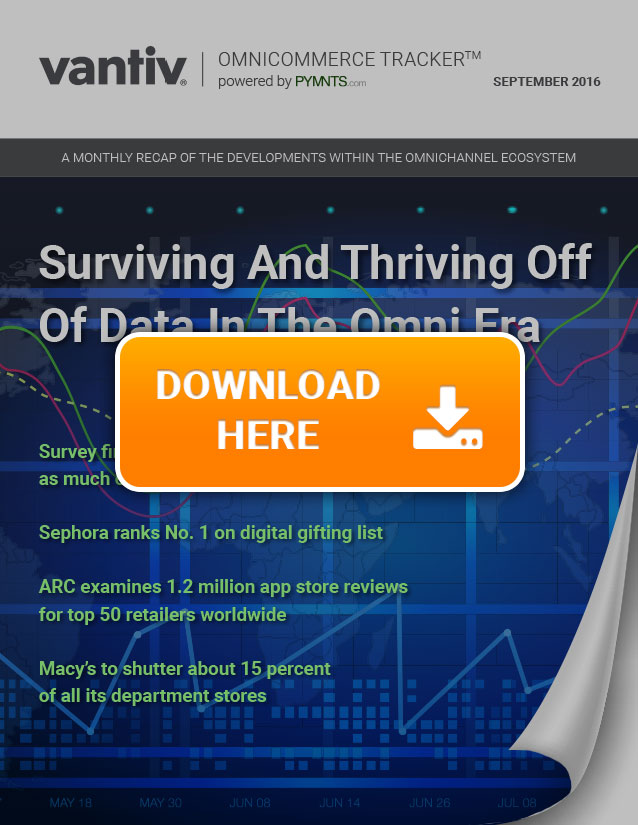Surviving And Thriving Off Of Data In The Omni Era

Like it or not, it’s all about the data. Retailers want to measure everything that happens inside their stores, but doing so could be a recipe for disaster rather than success. In September’s Omnicommerce Tracker™, RetailNext VP of Retail Consulting Shelley Kohan discusses the importance of collecting and understanding data before merchants can come up with a winning omnichannel campaign. That, and all the omnicommerce news from around the space in this month’s Tracker.
With big-box retailers, like Walmart, expected to spend more than $1 billion on eCommerce this year, merchants are making a concerted effort to bolster their omnichannel strategies. But significant investments aren’t just made on a whim, as retailers rely heavily on analytics to craft winning omnicommerce strategies.
Interpreting data correctly, however, can make all the difference between success and failure in the retail industry.
PYMNTS recently spoke with Shelley Kohan, vice president of retail consulting at RetailNext, about the challenges and opportunities retailers have when it comes to collecting and understanding data before trying to come up with an effective omnichannel campaign.
The San Jose, Calif.-based company works with more than 250 merchants in 50-plus countries to boost sales at brick-and-mortar locations and reduce costs by providing them with eCommerce-related customer data they can use to enhance both online and in-store shopping experiences.
Retailers Look To Expand Their Knowledge Base
Merchants tend to have “foundational information,” Kohan said, meaning they’re collecting data related to traffic or conversions. Once they have this foundation established, retailers begin asking themselves more questions to better understand the overall retail climate.
“They start wanting a deeper dive into the in-store kind of setup, the journey the shopper is taking, so we then offer additional technologies, which vary based on the retail format,” she said.
If a merchant doesn’t have a CRM program, Kohan said, that information can be valuable. For example, mall retailers want to know where customers go when they visit their store or before they get to the store and how that affects conversion.
That’s presumably why luxury retailer Bloomingdale’s and the NBA’s Atlanta Hawks, to name two high-profile examples, partnered with RetailNext. They were looking to better understand the mindset of their consumers — something made possible through software.
“We have retailers that are your traditional retailers … They are looking at a more global view of what’s happening within that store,” Kohan said. “They also want to understand big-picture trends of what’s happening by region.”
When it comes to the challenges different retailers face, smaller merchants are usually concerned with store design and how to maximize space. Meanwhile, specialty store retailers are typically focused on where customers are going and how much time they spend going there, as well as fixture optimization and full-path analysis, Kohan said.
Making Metrics Count
Meanwhile, brand-name companies, like Nike, have been performing significant data analytics and customer analysis for more than a decade.
“They are very good at understanding their customers and really targeting specific ones,” Kohan said.
But when it comes to outlet stores, Kohan said, they are constantly challenged with inconsistency of merchandise due to the business model.
Standard service outlet and discount stores, for instance, generally use only in-store technologies that are focused on operational issues, such as line management and service areas, instead of nonoperational areas.
RetailNext uses multiple technologies to track — or enable, as the case may be — customer data, such as beacons and in-store messaging.
“We have enabling technologies that allow us to measure not only how long but how much time they [store associates] spent [with the customer],” she said. “Most importantly, that technology then can be married up to conversion numbers and average transactions, and [retailers] can really begin to understand the importance of that interaction and what the optimum interaction time is.”
With so many technological options available on the market today, retailers are finding it difficult to identify which ones can help them the most. Another hurdle that merchants in some states face is rising minimum wages for store associates, Kohan said. But by having appropriate technologies in place, retailers may be able to address the situation.
These merchants will look at how to get higher productivity from their existing staff, Kohan said.
Retailer Pain Points
Kohan, who has worked in the retail industry for more than 30 years, said that often what can go wrong for retailers is that they only measure hours for everything instead of analyzing other metrics.
“They want to measure everything in the store, but you just can’t measure 10 different things at the same time,” she said.
Merchants need to make sure that store associates are being scheduled when traffic demand is at its highest, Kohan added.
“It’s not a high-level senior executive looking at labor hours,” she stated. “It’s really store managers understanding that customer-to-staff ratio, and I can tell you having seen this a million times where a store is not making conversion numbers. If you take a deep dive, you’ll see the customer-staff ratio runs from three to 17. When it gets above 12, you’re going to have a problem with conversion.”
While some retailers resort to using workforce management systems that help them schedule hours, Kohan said, a major mistake sellers make is setting the alignment for a season instead of continually checking to make sure it’s working correctly. She used the example of a general merchandise retailer that carries men’s, women’s and children’s items.
“We were measuring the interactions, when a customer came into the store and when an associate helped them,” she said. “And we measured the time that they spent together and related that back to conversion. What we found was that, in the kids’ department for [this] specialty store retailer, when that interaction time was low, it had a negative impact on conversion.”
This information can allow retailers to take action to improve customer-store associate interaction times and increase conversions, Kohan said.
……………..
To download the September edition of the Vantiv Omnicommerce Tracker™, click the button below.

